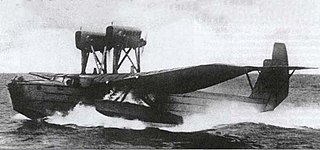
The Mikoyan-Gurevich MiG-8 Utka was a Soviet experimental aircraft. Built of wood, the aircraft was designed and built in 1945 to test the novel canard configuration. It also used a tricycle undercarriage, the first used by the OKB. It was modified to test a variety of vertical stabilizer and wingtip configurations and was later used as a liaison aircraft for many years by the design bureau.

The Tupolev TB-1 was a Soviet bomber aircraft, an angular monoplane that served as the backbone of the Soviet bomber force for many years, and was the first large all-metal aircraft built in the Soviet Union.

The Antonov A-40 Krylya Tanka was a Soviet attempt to allow a tank to glide onto a battlefield after being towed aloft by an airplane, to support airborne forces or partisans. A prototype was built and tested in 1942, but was found to be unworkable. This vehicle is sometimes called the A-40T or KT.

The Beriev Be-6 was a flying boat produced by the Soviet Beriev OKB. It was capable of accomplishing a wide variety of missions, such as long-range maritime reconnaissance, coastal and supply line patrols, torpedo/bombing strikes, mine-laying, and transport operations.
The Tupolev MTB-1 was a patrol flying boat built in the Soviet Union in the mid-1930s. It was a refined version of the unsuccessful Chyetverikov MDR-3. The revised design retained the MDR-3's hull, but added a newly designed, full-cantilever wing, a new tail, and a new engine installation featuring two tractor and one pusher unit. Trials began in March 1934 but the prototype was destroyed during one takeoff.

The ANT-8 was an experimental flying boat designed by Tupolev. It was designated the "MDR-2" by the military.
The RP-318 or RP-318-1 was USSR's first rocket-powered aircraft or Rocket Glider which "RP" stands for in Russian language. Beginning in early 1936 it was first known as RP-218-1 or "Objekt 218" before it was renamed to RP-318-1 in 1938 due to inner reforms of the Rocket Science And Research Institute.
The Nikitin NV-4 was a two-seat amphibious aircraft produced in the USSR in 1936.
The Nikitin MU-4 was an amphibian trainer aircraft produced in the USSR in 1936.
The Nikitin PSN-1 was a piloted glider anti-shipping missile produced in the USSR from 1937.
The DB-LK was a bomber aircraft designed and built in the USSR in 1939.
The BICh-11 was a twin-engined tailless research aircraft designed and built in the USSR from 1931.
The TA was an amphibious transport designed and built in the USSR from 1945.
The Bolkhovitinov DB-A was a heavy bomber aircraft designed and built in the USSR from 1934.
The Grigorovich M-1 was a flying boat designed by Dmitry Pavlovich Grigorovich and built in Russia in 1913.
The Tupolev ANT-10 was a prototype single-engined light bomber/reconnaissance aircraft of the 1930s. Only a single example was built, the Polikarpov R-5 being preferred.
The Yakovlev Yak-10 was a Soviet light liaison aircraft designed and built by the Yakovlev design bureau in the 1940s.
The Ilyushin DB-4 or TsKB-56 was a Soviet twin-engined bomber aircraft of the early 1940s. It was a development of the Ilyushin DB-3 and was intended as a replacement for the earlier aircraft, but only two prototypes were built; engine problems and the need to concentrate production on existing types following the German invasion of the Soviet Union in June 1941 meant that no more examples were built.
The Gribovsky G-28 was an advanced trainer for trainee fighter pilots, built in the USSR just before the German invasion in 1941. It satisfied VVS testing but changing priorities led to the abandonment of production plans.
The Grigorovich MK-1 was a large trimotor floatplane, built and tested in Imperial Russia in 1916.




